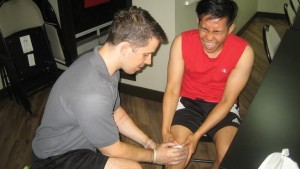A baker’s cyst is a cyst filled with fluid that causes a protuberance and there is a sensation of tightness that is felt behind the knee and the pain is severe when it is fully flexed or extending the knee. A baker’s cyst is also known as a popliteal cyst and it is the problem of the knee joints like arthritis or a tear in the cartilage. This condition causes the knee to produce plenty of fluids which results to a baker’s cyst.
If you want to learn how to provide relief to the symptoms of baker’s cyst, you can enroll in a first aid course today.
Symptoms of baker’s cyst
- There is pain in the knee
- Stiffness, swelling behind the knee and sometimes in the legs and gets worse when standing.
- Slight pain can be felt behind the knee and into the upper calf, especially when bending the knee or straightening the knee all the way.
The symptoms are severe after being active or even only for standing for a long time. Sometimes, the pocket of fluids found behind the knee can tear open and drain into the tissues of the lower leg and this will cause redness and swelling in that region.

Causes of baker’s cyst
A synovial fluid is a lubricating fluid that helps the legs swing smoothly and minimizes friction between the moving parts of the knee, but sometimes the knee will produce plenty of synovial fluid and will result in the building up of fluids in area found at the back of the knee which causes the baker’s cyst. This can occur due to the following:
- An injury of the knee such as a cartilage tear
- An inflammation of the knee joints that happens with various types of arthritis like rheumatoid arthritis or osteoarthritis that causes irritation of the knee.
Treatment and home remedies
- Allow the knee rest.
- Apply cold compress on the affected area for 10 to 15 minutes.
- Compress the knee with a wrap, brace or sleeve and raise the knee above the level of the heart particular at night time.
- Take over-the-counter medications for pain in order to reduce the pain and swelling like ibuprofen and naproxen.
- Use a cane, crutch, walker or some devices that can help a person get around and help rest the knee.
- If the person wears an elastic bandage over the knee, just ensure it is comfortable and not too tight that makes the legs numb or swell below the bandage
- Seek medical help if how much weight can be placed on the knees.
- Maintain a healthy weight since an overweight person puts extra strain on the knees.
Perform regular, gentle exercises to help in increasing the range of motion and to strengthen the muscles found around the knee and using a compression wrap or by placing ice on the joints can help in minimizing the pain.
